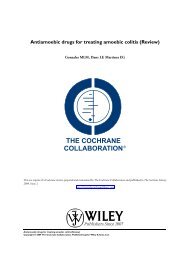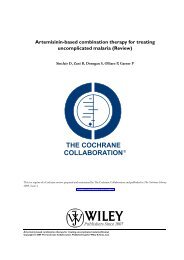Topical treatments for fungal infections of the skin and nails of the foot.
Topical treatments for fungal infections of the skin and nails of the foot.
Topical treatments for fungal infections of the skin and nails of the foot.
You also want an ePaper? Increase the reach of your titles
YUMPU automatically turns print PDFs into web optimized ePapers that Google loves.
tions is sparse. Combining data from 2 trials <strong>of</strong> ciclopiroxolamine<br />
versus placebo found <strong>treatments</strong> failure rates <strong>of</strong> 61% <strong>and</strong> 64%<br />
<strong>for</strong> ciclopiroxolamine. These outcomes followed long treatment<br />
times (48 weeks) <strong>and</strong> this makes ciclopiroxolamine a poor choice<br />
<strong>for</strong> nail <strong>infections</strong>. Better results were observed with <strong>the</strong> use <strong>of</strong><br />
amorolfine lacquer; 6% treatment failure rates were found after 1<br />
month <strong>of</strong> treatment but <strong>the</strong>se data were collected on a very small<br />
sample <strong>of</strong> people <strong>and</strong> <strong>the</strong>se high rates <strong>of</strong> success might be unreliable.<br />
Butenafine 2% produced a treatment failure rate <strong>of</strong> 20%.<br />
There is limited evidence about <strong>the</strong> efficacy <strong>of</strong> tea tree oil <strong>for</strong> <strong>skin</strong><br />
<strong>infections</strong>; it was evaluated in only one small trial however it was<br />
found to be ineffective <strong>for</strong> <strong>fungal</strong> nail conditions when compared<br />
with topical butenafine.<br />
Quality <strong>of</strong> <strong>the</strong> evidence<br />
The r<strong>and</strong>omised controlled trials in this review were generally well<br />
reported, <strong>and</strong> follow up rates were reasonable <strong>for</strong> such a condition.<br />
Since no trial reported <strong>the</strong> species obtained from participants who<br />
were resistant to treatment we cannot draw conclusions about susceptibility<br />
to individual compounds to help clinical decision-making.<br />
Little data was available about <strong>the</strong> long term outcomes associated<br />
with <strong>the</strong> use <strong>of</strong> anti<strong>fungal</strong> creams <strong>and</strong> <strong>the</strong>re is uncertainty<br />
about rates <strong>of</strong> reinfection <strong>and</strong> relapse.<br />
A U T H O R S ’ C O N C L U S I O N S<br />
Implications <strong>for</strong> practice<br />
All anti<strong>fungal</strong> compounds demonstrated some success in curing<br />
athlete’s <strong>foot</strong>. The best results were observed with <strong>the</strong> use <strong>of</strong> allylamines<br />
<strong>and</strong> <strong>the</strong>re is a small amount <strong>of</strong> evidence that butenafine<br />
may be similarly good. Azoles are also very effective <strong>and</strong> participants<br />
should be advised that although all azoles appear to be similarly<br />
effective, using an azole cream <strong>for</strong> four weeks is likely to produce<br />
better results than using it <strong>for</strong> one week. Azoles may also be<br />
References to studies included in this review<br />
Ablon 1996 {published data only}<br />
Ablon G, Rosen T, Spedale J. Comparative efficacy <strong>of</strong> naftifine<br />
oxiconazole <strong>and</strong> terbinafine in short term treatment <strong>of</strong> tinea pedis.<br />
International Journal <strong>of</strong> Dermatology 1996;35(8):591–3.<br />
Akers 1989 {published data only}<br />
Akers WA, Lane A, Lynfield Y, Greenberg J, Hall J, Mangan C, et<br />
al.Sulconazole nitrate 1% cream in <strong>the</strong> treatment <strong>of</strong> chronic<br />
moccasin type tinea pedis caused by trichophyton rubrum. Journal<br />
<strong>the</strong> <strong>of</strong> American Academy <strong>of</strong> Dermatology 1989;21(4):686–9.<br />
R E F E R E N C E S<br />
<strong>Topical</strong> <strong>treatments</strong> <strong>for</strong> <strong>fungal</strong> <strong>infections</strong> <strong>of</strong> <strong>the</strong> <strong>skin</strong> <strong>and</strong> <strong>nails</strong> <strong>of</strong> <strong>the</strong> <strong>foot</strong>. (Review)<br />
Copyright © 2009 The Cochrane Collaboration. Published by John Wiley & Sons, Ltd.<br />
more efficacious than tolnaftate but <strong>the</strong>y seem no more efficacious<br />
than undecanoic acid. There is limited evidence about <strong>the</strong> efficacy<br />
<strong>of</strong> tea tree oil <strong>for</strong> <strong>skin</strong> <strong>infections</strong>.<br />
There is little evidence that topical anti-<strong>fungal</strong>s are effective in <strong>the</strong><br />
management <strong>of</strong> onychomycosis or <strong>fungal</strong>ly infected toe <strong>nails</strong>. The<br />
majority <strong>of</strong> available data demonstrate low cure rates after long<br />
treatment times with ciclopiroxolamine. Amorolfine <strong>and</strong> butenafine<br />
may be much more effective than ciclopiroxolamine <strong>and</strong><br />
tea tree oil but only a few observations are available.<br />
Implications <strong>for</strong> research<br />
The estimates <strong>of</strong> effectiveness <strong>of</strong> allylamines <strong>and</strong> azoles relative<br />
to placebo have conclusively demonstrated <strong>the</strong>se drugs to be <strong>of</strong><br />
greater effectiveness <strong>and</strong> we recommend that no more placebo<br />
controlled trials <strong>of</strong> allylamines or azoles should be conducted.<br />
More direct comparisons <strong>of</strong> undecanoic acid <strong>and</strong> tolnaftate with<br />
allylamines <strong>and</strong> azoles <strong>for</strong> athlete’s <strong>foot</strong> are required. Large r<strong>and</strong>omised<br />
controlled trials comparing <strong>the</strong> effectiveness <strong>of</strong> topical<br />
amorolfine <strong>and</strong> butenafine are needed to establish an alternative<br />
to oral <strong>treatments</strong> <strong>for</strong> toe nail <strong>infections</strong>.<br />
A C K N O W L E D G E M E N T S<br />
For help with <strong>the</strong> update <strong>of</strong> this review <strong>and</strong> <strong>the</strong> previous version<br />
we thank: Sally Bell-Syer, Kath Cross, Zelda Di Blasi, Alison Eastwood,<br />
Annelise Emmans, Jill Ferrari, Nick Freemantle, Simon<br />
Gilbody, Mark Goodfield, Rod Hay, Mark Petticrew, Daphne Russell,<br />
Ian Russell, David Torgerson, Trevor Sheldon, Fujian Song,<br />
Wendy Tyrrell, Hywel Williams <strong>and</strong> <strong>the</strong> Cochrane Skin Group,<br />
<strong>and</strong> Philip Young. The first version <strong>of</strong> this review was funded by<br />
<strong>the</strong> Wales Office <strong>of</strong> Research <strong>and</strong> Development <strong>for</strong> Health <strong>and</strong><br />
Social Care (WORD)<br />
We would also like to thank Rachael Hart <strong>for</strong> helping with <strong>the</strong><br />
first version <strong>of</strong> <strong>the</strong> review <strong>and</strong> some data extraction <strong>for</strong> this update.<br />
Aly 2003 {published data only}<br />
∗ Aly R, Fisher G, Katz HI, Levine N, Lookingbill DP, Lowe N, et<br />
al.Ciclopirox gel in <strong>the</strong> treatment <strong>of</strong> patients with interdigital tinea<br />
pedis. International Journal <strong>of</strong> Dermatology 2003;42(Suppl 1):<br />
29–35.<br />
Bagatell 1986 {published data only}<br />
Bagatell FK. Elimination <strong>of</strong> dermatophytes causing tinea pedis<br />
interdigitalis with once daily application <strong>of</strong> bifonazole 1% solution.<br />
Advances in Therapeutics 1986;3:265–71.<br />
23








